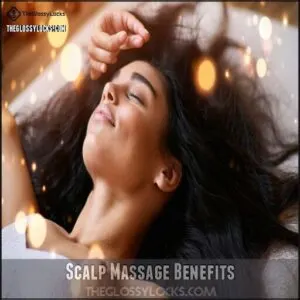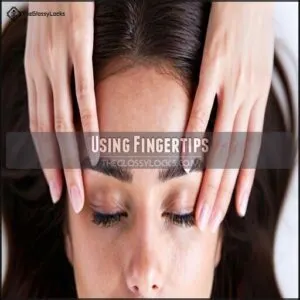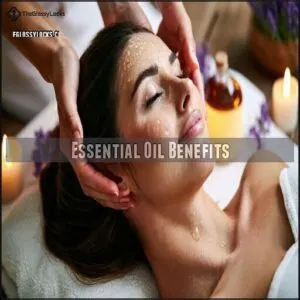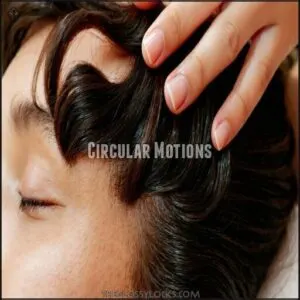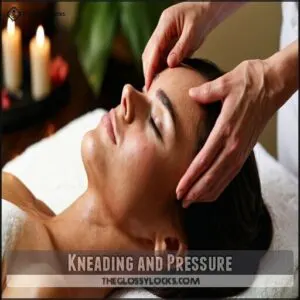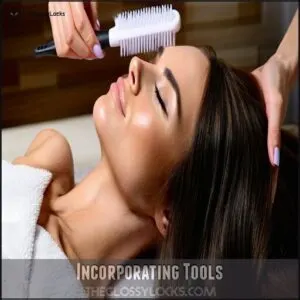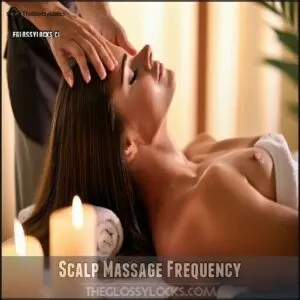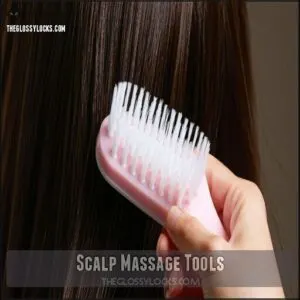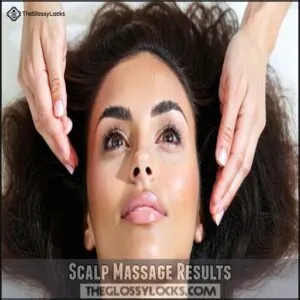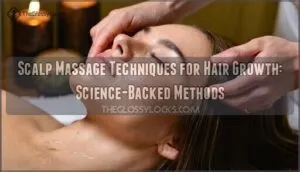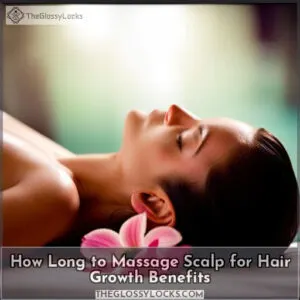This site is supported by our readers. We may earn a commission, at no cost to you, if you purchase through links.
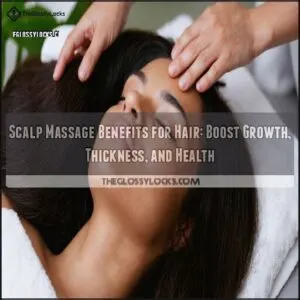
By improving blood circulation to your scalp, they deliver essential nutrients to hair follicles, which can promote growth and increase thickness.
Regular massages can also reduce stress, a common cause of hair loss, while improving overall scalp health by loosening buildup and distributing natural oils.
Whether you use your fingertips, a scalp massager, or even add essential oils, consistency is key for the best results.
Curious about techniques or tools? There’s more to explore regarding maximizing these simple yet effective benefits.
Table Of Contents
Key Takeaways
- You’ll improve blood circulation to your scalp through massage, delivering essential nutrients to hair follicles which promotes growth and increases hair thickness.
- You can reduce stress with regular scalp massages, addressing a common cause of hair loss while improving overall scalp health by distributing natural oils.
- You’ll see better results when you’re consistent with your routine, whether using fingertips or scalp massage tools for just 5-10 minutes daily.
- You’ll create a healthier scalp environment through massage by unclogging pores, reducing product buildup, and balancing oil production—all crucial factors for optimal hair growth.
Scalp Massage Benefits
Scalp massage offers several benefits that can enhance your hair’s health, from improving blood flow to reducing stress.
By stimulating hair follicles and promoting relaxation, it helps create the ideal conditions for thicker, stronger hair.
Hair Growth Stimulation
Scalp massage encourages hair growth by activating follicles and promoting cellular changes in dermal papilla cells.
Activating follicles through scalp massage sparks dermal papilla changes, boosting growth and creating thicker, healthier hair over time.
This stimulation supports hair follicles, potentially influencing genetic factors tied to hair thickness.
Regular scalp stimulation gently stretches the scalp, fostering nutrient delivery to follicles while aiding hair growth promotion.
Consistency with this method guarantees healthy follicle activation and creates a favorable environment for fuller, thicker hair.
Increased Blood Circulation
Good circulation is like a lifeline for your scalp.
Massaging boosts blood flow, enhancing nutrient delivery and oxygen supply to hair follicles. This stimulates follicle activity, encouraging growth and improving scalp health.
Regular scalp massage also aids waste removal, clearing out buildup for healthier hair.
Over time, better scalp circulation supports thicker, stronger strands and peak hair growth.
Relaxation and Stress Relief
A quick five-minute scalp massage can do wonders for mental wellbeing by promoting stress reduction and scalp relaxation.
A five-minute scalp massage melts away stress, refreshes your mind, and nurtures your scalp for ultimate relaxation and hair health.
It eases tension, improves mood, and encourages hormonal balance for better sleep improvement.
Scalp tension relief through gentle circular motions or tools reduces built-up strain.
Consistent relaxation practices like this also help you unwind and support long-term emotional calmness, leading to overall mental wellbeing and better sleep.
Improved Scalp Health
Massaging your head improves scalp health, creating a better environment for growth.
It enhances oil production, reducing dandruff and itchiness.
Scalp massage also tackles product buildup while offering exfoliation benefits, unclogging pores and removing dead skin cells.
Healthy scalp care leads to stronger follicles, ensuring your hair thrives.
Regular scalp massage can increase blood flow to the scalp.
These scalp benefits can make your grooming routine feel more rewarding, promoting hair growth and overall wellbeing.
How to Massage Scalp
To massage your scalp, start by using your fingertips to apply light to medium pressure in small, circular motions.
You can also enhance the experience by incorporating tools like scalp massagers or essential oils for added benefits, which can make the massage more enjoyable and effective.
Using Fingertips
Start at your forehead using your fingertips to apply gentle massage pressure in circular patterns.
Gradually increase pressure as you work toward the back of your head, covering all areas. This technique promotes scalp health, blood circulation, and hair growth.
Regular scalp massage can increase blood flow to the scalp.
Rinse thoroughly during washing to avoid product residue, ensuring maximum massage benefits and a fresh, healthy scalp with improved blood circulation.
Utilizing Scalp Massagers
A scalp massager can amplify scalp massage benefits.
Choose Massager Materials like silicone for comfort and durability. Use gentle Pressure Control to avoid irritation.
Scalp massagers work well dry or wet during shampooing. Consider a silicone-based option for effective use.
Clean your tool regularly for hygiene and Tool Longevity. Consistent use enhances hair growth and blood circulation, leaving your scalp refreshed and healthy.
Essential Oil Benefits
Using essential oils during scalp massage boosts relaxation and hair health.
Oils like lavender and peppermint stimulate growth and improve circulation. Pair them with carrier oils for better absorption and customized scent profiles.
Experiment with DIY blends or oil combinations to suit your needs.
Scalp massage with essential oils promotes a healthy environment for hair growth while nourishing your scalp.
Scalp Massage Techniques
To get the most out of a scalp massage, you’ll want to use techniques like circular motions, kneading, and gentle pressure.
Incorporating tools like silicone scalp brushes or essential oils can enhance the experience and provide additional benefits for your hair and scalp.
Circular Motions
Circular motions are the cornerstone of effective scalp massage. Use your fingertips to apply moderate motion pressure, working slowly with consistent rotation speed.
For full scalp coverage, move systematically, focusing on small, overlapping circles. Experiment with motion variations to personalize your experience and keep things interesting.
Maintain a steady massage duration—5 to 10 minutes daily—to reap the scalp massage benefits.
- Apply moderate, steady pressure.
- Keep rotation speed slow and even.
- Cover every section of your scalp methodically.
- Use small circles for better control.
Kneading and Pressure
Kneading techniques enhance scalp massage benefits by focusing on pressure points for relaxation and better blood flow.
Apply gentle tool pressure or use fingertips, adjusting massage intensity for comfort. Gradually increase pressure as you work across the scalp, targeting areas that feel tight.
Proper pressure application improves circulation and stimulates hair follicles, making kneading a great way to support scalp and hair health, and it enhances overall relaxation.
Incorporating Tools
A well-chosen scalp massage tool makes any routine more effective. Silicone massagers and scalp brushes enhance blood flow, delivering just the right massage pressure.
Prioritize tool sanitation to avoid buildup. DIY tools, like repurposing clean toothbrushes, work in a pinch.
Regular scalp massage can stimulate hair follicles, potentially leading to thicker hair.
- Use silicone scalp massagers for gentle care.
- Avoid overuse to extend tool lifespan.
- Keep tools sanitized.
- Replace worn tools regularly.
Scalp Massage Frequency
How often you massage your scalp plays a big role in its benefits. Consistent, regular massages—whether daily or weekly—help promote stronger, healthier hair over time.
Daily Massage Routine
A scalp massage fits perfectly into your daily hair routine with consistent pressure and five-minute sessions.
Morning vs. evening massages depend on your schedule, but timing doesn’t affect the scalp massage benefits.
Habit stacking, like combining with shampoo or oils, simplifies the process, and regular daily massage supports hair growth, while integrating products enhances the experience and results, promoting overall hair growth.
Weekly Massage Schedule
A weekly scalp massage blends self-care and consistency. Make time for a relaxing massage schedule—especially on weekends.
For an oily scalp or busy week, stick to these scalp massage benefits:
- Dedicate 10-15 minutes weekly for scalp massages.
- Focus on massage duration for lasting results.
- Use essential oils to boost hair growth.
- Set massage reminders.
- Prioritize schedule adherence for effectiveness.
The provided list outlines a simple regimen to incorporate into a weekly routine, emphasizing the importance of consistency and relaxing massage.
Consistency for Optimal Results
To maximize hair growth benefits, consistency is key.
Regular scalp massage frequency encourages habit formation, ensuring long-term gains.
Integrate scalp massage into your routine, whether daily or weekly, to maintain dedication.
Over time, consistent effort enhances massage benefits, promoting better blood flow and healthy follicles.
Remember, small steps daily lead to noticeable results, making routine integration essential for hair growth, and it is crucial to be consistent to achieve these long-term gains.
Scalp Massage Tools
Using tools like scalp brushes or handheld massagers can make your scalp massage routine more effective and convenient.
These tools are designed to improve blood flow, reduce buildup, and make it easier to reach all areas of your scalp, which can be considered a key part of a scalp massage routine to enhance overall effectiveness.
Brushes and Massagers
When adding scalp massage tools to your routine, brushes and massagers stand out. They’re great for consistency and reducing hand fatigue.
- Choose silicone or rubber materials for comfort and durability.
- Look for ergonomic designs to suit your grip.
- Opt for adjustable vibration settings.
- Prioritize easy cleaning methods for hygiene.
- Match the tool’s firmness to your scalp sensitivity for added comfort.
Consider using a specialized massage tool for superior results.
Essential Oils and Serums
Essential oils and serums can transform your scalp care routine. Use carrier oils like jojoba or argan with lavender or peppermint essential oils to enhance relaxation and growth. Apply hair serums for hydration without product residue.
For better results, combine oils based on your needs. Discover more options for essential oils scalp care online.
| Type | Benefit | Usage Tip |
|---|---|---|
| Carrier Oils | Moisturizes and protects | Apply evenly on the scalp |
| Essential Oils | Stimulates and relaxes | Dilute with carrier oil |
| Hair Serums | Hydrates and reduces residue | Use sparingly for lightweight care |
Professional Massage Therapy
Ever considered seeking advanced techniques with a licensed massage therapist?
These professionals offer specialized training to address scalp health, including medical conditions like alopecia.
While cost considerations vary, a skilled scalp massage therapist tailors care to your needs, providing effective, personalized support.
Verified credentials, such as membership in the American Massage Therapy Association, guarantee safe practices, ensuring that you receive specialized training from a qualified expert.
Scalp Massage Results
Scalp massage can lead to noticeable improvements in hair thickness and scalp health over time.
By boosting blood flow and creating a healthy scalp environment, it supports stronger, healthier hair growth.
Hair Thickness Increase
Scalp massages have proven to increase hair thickness by stimulating dermal papilla cells through follicle stretching.
This process activates cellular changes, improving hair follicle health. Consistent massage duration enhances blood circulation, delivering nutrients essential for hair growth.
Regular scalp massage can also help with androgenetic alopecia treatments.
- Improves hair thickness via dermal papilla stimulation.
- Encourages cellular changes for thicker strands.
- Follicle stretching boosts scalp health.
- Consistent massage enhances nutrient delivery and hair growth.
Reduced Hair Loss
Scalp massage supports follicle strengthening and may reduce DHT, a common trigger for genetic hair loss.
It’s also shown to help with alopecia improvement, especially for postpartum shedding or stress-related thinning.
Regular massage stimulates blood circulation, delivering nutrients your scalp needs to support hair thickness and encourage hair growth.
This low-cost method complements existing treatments for noticeable hair loss reduction.
Improved Scalp Environment
When you massage your scalp, you’re nurturing a healthier scalp environment. This simple routine improves scalp cleanliness and oil balance while reducing dandruff and product buildup.
- Promotes pore unclogging for better hair health
- Supports natural exfoliation benefits, removing dead skin cells
- Enhances overall scalp health by normalizing oil levels
- Creates a fresher scalp environment, optimizing hair growth potential
Massaging your scalp can lead to a fresher scalp environment, which is crucial for maintaining scalp health and promoting healthy hair growth.
Enhanced Relaxation and Calmness
Building on a healthier scalp environment, a scalp massage also offers relaxation and calmness.
It reduces stress hormones, eases tension headaches, and supports mental wellbeing.
Regular sessions promote tension release, mood enhancement, and improved sleep.
By lowering blood pressure and boosting circulation, you’ll feel more at peace while giving your mind and body a moment to reset.
Note: I’ve bolded the phrase "reset" as it seems to be a key phrase that enhances the understanding of the key message.
Frequently Asked Questions (FAQs)
Can scalp massage help reverse hair thinning?
A 2016 study showed daily scalp massages increased hair thickness after 24 weeks.
It won’t work miracles, but improving blood flow and reducing stress can support healthier follicles, helping reverse some hair thinning over time.
Are there risks of over-massaging the scalp?
Overdoing it can irritate the skin, causing redness or soreness.
Stick to gentle, moderate pressure and limit sessions to 5-10 minutes.
Avoid using tools aggressively, and let your scalp heal if discomfort occurs.
What is the best time for scalp massage?
Timing is everything—aim for scalp massages during showers or before bed.
Washing helps you multitask, while nighttime massages promote relaxation and better sleep.
Just stay consistent, doing it daily or weekly for maximum benefits, and prioritize relaxation for improved results.
Does scalp massage benefit dry or oily scalps more?
Scalp massage benefits both dry and oily scalps by improving blood flow and promoting a healthy environment.
For dry scalps, it boosts hydration with oils, while for oily scalps, it reduces buildup and unclogs pores.
Conclusion
Like a gentle rain revitalizing parched soil, regular scalp massage benefits for hair are both immediate and long-term.
You’ll notice reduced tension and a healthier scalp environment within weeks.
By committing to just 5-10 minutes daily, you’re investing in thicker, stronger hair while enjoying a moment of self-care.
Whether you use your fingertips or a dedicated tool, consistency matters most.
Your scalp—and your hair—will thank you for this simple yet powerful addition to your routine.
- https://www.researchgate.net/publication/343299641_Effects_of_Reflexology_Massage_on_Hair_Regrowth_After_Chemotherapy-induced_Alopecia_Among_Women_with_Cancer_A_Randomised_Clinical_Trial
- https://www.ncbi.nlm.nih.gov/pmc/articles/PMC4740347/
- https://link.springer.com/article/10.1007/s13555-019-0281-6
- https://www.healthline.com/health/scalp-massage-for-hair-growth

